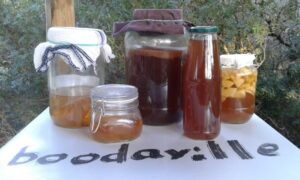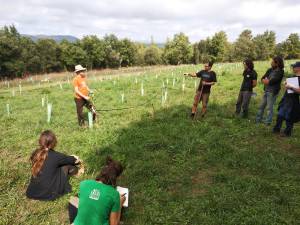Regenerative Agroforestery at Mas les Vinyes
Posted on Oct 19, 2019
I finally had the chance to visit the amazing Mas les Vinyes in September. The course on Regenerative Agroforestry is three weekends in total, and I’m writing to share my impressions and some of what I learnt at the first one. The weekend was absolutely brilliant – just to see the project was incredible, and we also had Carles and Sergi facilitating excellent sessions; theory, visiting the examples on site, and a practical, plus we stayed overnight and ate amazing food with the community there.
Even though the climate and land use is very different to Boodaville – it is greener and with a lot of animal grazing and grass – the sessions were really well adapted to give information to individual projects.
Boodaville has changed direction from the original permaculture eco-village plan, and as we see the world getting crazier, with people trying desperately to cling to power and money while environmental crises are not addressed, I am getting more and more interested in soil. Building soil. Fertile, nutrient filled, rich and bursting with life. Where fungus creates connections between different plants and trees growing together into a resilient ecosystem. The new direction is developing regenerative agriculture in the valley – a tough challenge in this water scarce, soil degraded area. I never thought I would be a farmer, but the impact of successful regenerative agriculture will be beautiful. And on the journey to get there, after ten years of creating, coordinating and administrating Boodaville, I now have the pleasure of learning, exploring, going out and connecting with other people and projects, and designing.
If you would like to know more about our new direction (including permaculture education, regenerative farming and ecosystem restoration please email me Lou : thegurney@gmail.com and I will send you information)
There is loads of info at Mas les Vinyes on their youtube channel and a great project EDUCA PERMACULTURA
SATURDAY MORNING – WHAT IS RA?
Sergi opens with a little speech about how Syntropic Agriculture won’t work in Spain as it uses loads and loads of water. I’m really interested in Syntropy and will bear this in mind and look forward to learning more!
What is regenerative? Productive, self-fertilising, healthy with no plagues, resilient (can withstand and recover from shocks)
What is degenerative? Production requires energy, requires nutrients, and leads to dead soil/ desertification
Jem Bendell is mentioned : DEEP ADAPTATION he wrote a paper on this as a way of coping with the collapse of our living systems and all the social craziness this has led to. The 4 R’s are Renounce, Resilience, Restoration, Reconciliation. Part of the process is to accept how bad things really are, to accept that people will be distracted by clickbait, and adverts, and continue as they have been “programmed to function” (words from the Lily Allen song “The Fear”!) Then you can find your way without these things damaging you, and engage with anyone. Ok I’m drifting off topic here…
We can adapt Regenerative Agroforestry (RA) to climate change, using Microclimates, Infiltration, the fact that forests have efficient, Slow transpiration rates – they don’t transpire all the water as soon as the sun shines like cereals (and rocket! Rocket will dry out your soil!!), Biodiversity, Low energy needs.
Characteristics of RA
- tree layer
- soil is a living element
- symbiosis flora / fauna / micro fauna
- efficient design
Types of RA
- Food forest
- Analogue forestry. This is where you imitate the natural forest of the region, but can use homologous varieties – so you might use a slightly more drought resistant variety of a tree, or a slightly different bush that produces fruit that humans eat, and this is agriculture, so you will be planting productive trees in the system. In permaculture design this would be in zone 3 / 4 much less maintenance than the food forest.
This picture is an analogue forestry design at Mas les Vinyes (MLV), they have replicated the forest behind using ecological surveying, and put the productive trees at the edges of the rows where they can be easily harvested. They have planted many species, indigenous and homologous trees imitating the climax forest behind. They only water the productive trees that are not native. (This project is also being funded by a research program – they are looking at what lives and dies to see how climate change may be affecting what natives live and die now)
They say there is a certification called “Forest (Garden) Product” so for responsible consumers out there you can look that up and buy even better than organic!
(more types of RA)
- Alley cropping – they do some of this at MLV. Some crops do better in the “alleys” between the trees than they do without trees. This is part of the culture in many places not a “new” idea.
Check out the amazing Paulonia tree – a species that has loads of useful properties in RA systems – but needs a lot of water so no good for Boodaville.
- River Agroforestry – this is illegal in Catalunya as within a certain distance from the river you aren’t allowed to farm. If you want to use animals in the system make sure they can’t get all the way to to river banks as their behaviour will increase erosion. I see a real potential for this in the bottom of the valley at Boodaville where there is no “river” but there is underground water – you can already see the bigger trees there making the most of the water available, it would be great to start putting some productive trees and designing a system around there.
- Perimeter Agroforestry – where the trees follow a pattern on the design (NOT just the edges of fields around monoculture) but maybe following a swale/key line, or designing perimeters into your land to have more forest.
- Silvopastoreo – animal agroforestry is what they do here at MLV.
Nice graph about mechanisation. Imagine mono culture cereal is 100% mechanisation – you drop down in the following order – alley cropping, 75%, perimeter about 60%, then silvopastoreo 50%, River about 40%, analogue 30% and food forest down the bottom at about 15%.
A tour of MLV
1st stop is the alley cropping, where we see rows of fruit trees with support species such as Eleagnus, Consuela, Buffalo Berry, Caragana. They have a nice Goji next to a Mulberry. Olivo ruso is in the system
2nd stop some “guilds” next to the veg garden. The border, at top of terrace wall is a great mix – rosemary, eleagnus and a pink flower ASK SERGI!!. They have a climber that got out of control, be careful with fast growing climbers. passion flower, nispero,
3rd stop analogue forestry
4th stop in the woods – they had cut down all the spikey, early succession bushes (the ones we get at Boodaville!) to leave space for sheep food and sheep?
Full list of species talked about with Sergi for Boodaville / water scarce poor soils
Cytisus Coronilla
Hippopae Rhamnoides – get male and femail, has yellow spine
Alfalfa Arbolia
Paulowina?
Capers?
Esparago
Pulsatilla (or something that sounds similar)
Cerbuxa (pruny kind of bush, something that sounds similar to this)
Caragana (Anna took seeds from Sergi)
Tanoceto (Anna took seeds from Sergi)
Palomera (?)
SATURDAY AFTERNOON – DESIGN
Process
- define vision
- analysis using permanence scale from yeoman. In order of permanent down to less permanent: – climate, topology (get a proper topological survey for new project – Jesus Ruiz can do this), water, roads/access, trees (dominant, abundant, frequent, occasional, rare, non-existent that would be expected), structures, sub-divisions, soil.
- map of the land
- sector analysis and preliminary zone map (Fire, Air, Water, Earth for sectors)
- study of homologous ecosystems and biotic factors
- define objectives of the system that need to be designed – including, market, economic, social ecosystem
- have strategies like layers to cover time while trees go (eg growing veg under trees before they get to maturity)
- define AR system to use
- choose what to grow
Choosing what to grow :
decide on main cultivations, secondary cultivations, morfología y necesidades, and choose your support species. Support species have the following functions : mineral accumulators, creating organic matter, attracting insects, improving soil, covering soil.
SECOND PART OF DESIGN
- proyección de especies
- timeline for action
- IMPLEMENTATION!!!
We then looked at two projects from members of the group and did an amazing application of all of the above, in about one hour we took two groups through the process and actually had half the design on the board! The best design session I’ve ever done.
Practical stuff that came up : If you are planting anything that competes for water put it more than 1.5m from tree. In general don’t plant permanent stuff closer than 50cm. Avellanas (hazelnuts) need 1000mm a year rainfall. oh. so maybe they won’t grow at Boodaville then.
SUNDAY – MICROBIOLOGY OF SOIL
Living soil has minerals, microorganisms and organic matter.
Aerobic microbiology makes humus. Anaerobic microbiology is what takes the minerals from the Roca Madre. Tractors mix these two, and that is BAD.
Structure : you need clay particles to hold soil together and the elements with a negative charge stick to clay (Ma, Mg, Z) The elements with a positive charge stick to the Roca Madre (mother rock. i’m sure it has a better name in English).
Fertility – Think about now, in the near future and in the long term. (This is where we have been going WRONG)
Fertility now : minerals are in the soil and water transplants them to plants once they are available.
Fertility for the next ten years : The soils needs organic matter. one way to get this is to let animals graze and eat 50% of the top of the plant. This doesn’t kill the plant (good) but also does mean the plant is damaged enough to lose 25% of its roots (good). The roots then become organic matter in the soil. So in RA we want to lose 50% of the plants at the top.
Plants auto regulate themselves, so if they lose leaves, then they will lose some roots. And if they lose roots, they will then lose leaves.
Ants take sugar (seeds, energy) down into the ground where they make fungus. Ants eat fungus. They even make different fungus in different places so they are resilient, and if some doesn’t grow, then the other ones will. Ants know more about different types of fungus than humans.
There are three pages of notes left!
Until I get another chance that is all for now








